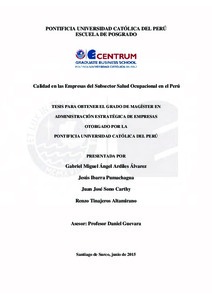| dc.contributor.advisor | Guevara Sánchez, Daniel Eduardo | |
| dc.contributor.author | Ardiles Álvarez, Gabriel Miguel Ángel | |
| dc.contributor.author | Ibarra Pumachagua, Jesús | |
| dc.contributor.author | Sono Carthy, Juan José | |
| dc.contributor.author | Tinajeros Altamirano, Renzo | |
| dc.date.accessioned | 2019-08-28T22:22:52Z | |
| dc.date.available | 2019-08-28T22:22:52Z | |
| dc.date.created | 2015-06 | |
| dc.date.issued | 2019-08-28 | |
| dc.identifier.uri | http://hdl.handle.net/20.500.12404/14841 | |
| dc.description.abstract | La salud ocupacional es considerada como pilar fundamental para el crecimiento de
las organizaciones y por ende es un aspecto importante para el progreso del país. Su actividad
va dirigida a proteger y preservar la salud de los trabajadores ante los riesgos que forman
parte sus actividades diarias, como son las enfermedades o accidentes ocupacionales. Dada su
significancia y entendimiento por las organizaciones peruanas, se deduce que las mismas
deben garantizar un servicio de calidad.
Es por ello, que la presente investigación tiene por objeto identificar si las empresas
del Subsector Salud Ocupacional en el Perú con Sistema de Gestión de Calidad (SGC) tienen
un mayor nivel de calidad comparado con aquellas que no tienen un SGC. Se ha diseñado un
estudio con alcance descriptivo y explicativo, ya que además de encontrar la relación entre la
variable independiente y la dependiente, se ha caracterizado el nivel de calidad del subsector,
siendo el punto de partida para las futuras mejoras. El enfoque es cuantitativo, al utilizar el
instrumento de Gestión de la Calidad Total (TQM: Total Quality Management), que presenta
35 enunciados cuyas respuestas se obtuvieron en la escala de Likert, abarcando una muestra
de 100 empresas a partir de una población que tiene 135 centros de salud ocupacional, por lo
que el error muestral ha sido del 5% y los resultados son extensibles a toda la población.
Se concluye que no existen diferencias significativas en el cumplimento percibido por
las empresas que poseen un Sistema de Gestión de Calidad (SGC) y las que no. Solamente se
encontraron diferencias significativas en los siguientes factores críticos de (Benzaquen,
2013): (a) Alta Gerencia, (b) Auditoría y Evaluación de la Calidad, (c) Control y
Mejoramiento del Proceso, (d) Círculos de Calidad y (e) Enfoque hacia la Satisfacción del
Cliente. Las recomendaciones que se desprenden del estudio cubren distintos aspectos y
especialmente el desarrollar un diseño del servicio, que incluya sus aspectos intangibles,
basado en los requerimientos de los clientes y con el compromiso de la mejora continua. | es_ES |
| dc.description.abstract | Occupational Health is considered as a fundamental pillar for growth in organizations
and as an important issue for country's progress. Its activity is to protect and preserve the
workers’ health from risks that could be generated for their daily activities, such as diseases
or accidents in work place. Since the sector has great importance, there is needed to provide
high quality service.
For this reason, this research aims to identify if there exists an impact on the level of
quality provided by implementation of any Quality Management System (QMS). In order to
achieve it, a research with descriptive and explanatory scope has been designed, because as
well as finding the relationship between the independent variable and the dependent, the level
of quality has been characterized, being a base level for future improvements. The study has a
quantitative approach, using TQM instrument which contains 35 statements that have been
answered using a Likert scale. It has been applied to a sample of 100 companies from a
population of 135 occupational health centers, so the sampling error was 5% and the results
can be properly extended to the entire population.
The findings indicate that there are not significant differences in quality level between
companies with QMS and those that do not have it. Only in the next factors exist a clear
difference: (a) Senior Management, (b) Quality Auditing and Evaluation, (c) Control and
Process Improvement, (d) Quality Circles and (f) Focus on Customer Satisfaction. In the
future, organizations on this industry, should pay more attention to service procedures design,
involving all employees with an holistic vision. | es_ES |
| dc.language.iso | spa | es_ES |
| dc.publisher | Pontificia Universidad Católica del Perú | es_ES |
| dc.rights | info:eu-repo/semantics/openAccess | es_ES |
| dc.rights.uri | http://creativecommons.org/licenses/by-nc-nd/2.5/pe/ | * |
| dc.subject | Salud ocupacional--Perú | es_ES |
| dc.subject | Calidad total | es_ES |
| dc.subject | Investigación cuantitativa | es_ES |
| dc.title | Calidad en las empresas del subsector salud ocupacional en el Perú | es_ES |
| dc.type | info:eu-repo/semantics/masterThesis | es_ES |
| thesis.degree.name | Maestro en Administración Estratégica de Empresas | es_ES |
| thesis.degree.level | Maestría | es_ES |
| thesis.degree.grantor | Pontificia Universidad Católica del Perú. CENTRUM | es_ES |
| thesis.degree.discipline | Administración Estratégica de Empresas | es_ES |
| renati.advisor.dni | 09412483 | |
| renati.advisor.orcid | https://orcid.org/0000-0002-6374-8062 | es_ES |
| renati.author.dni | 07633572 | |
| renati.author.dni | 25707324 | |
| renati.author.dni | 41928369 | |
| renati.author.dni | 29611950 | |
| renati.discipline | 413307 | es_ES |
| renati.level | https://purl.org/pe-repo/renati/level#maestro | es_ES |
| renati.type | https://purl.org/pe-repo/renati/type#tesis | es_ES |
| dc.publisher.country | PE | es_ES |
| dc.subject.ocde | https://purl.org/pe-repo/ocde/ford#5.02.04 | es_ES |






